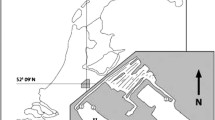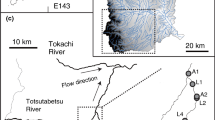Abstract
-
1.
Monthly quantitative samples of the invertebrate fauna (except Protozoa) in a small pond were taken over a period of three years. During one year, insect emergence traps were in operation. Water temperatures were recorded during the investigation.
-
2.
The most abundant organisms in the pond were Phaenocora typhlops, Limnodrilus hoffmeisteri and Chaoborus crystallinus. Certain species of Micro-Crustacea and Chironomidae were also abundant but these groups have been dealt with elsewhere (see p. 66). Dendrocoelum lacteum, Polycelis nigra, Helobdella stagnalis, Lumbriculus aariegatus, Tubifex tubifex, Planorbis complanatus, and Asellus meridianus also occurred in considerable though lower numbers; other species occurred in low numbers.
-
3.
The life-cycles and changes in numbers of the more numerous species are considered. The life-histories of D. lacteum, P. nigra, H. stagnalis, P. complanatus, A. meridianus are in agreement with published information. P. typhlops is seasonal in occurrence, being active from May to Sept. inclusive. Times of emergence of adults of various insect species agree with information available in the literature.
-
4.
The life-cycle of L. hoffmeisteri in the pond is as follows: young worms hatch in spring/summer and form the bulk of the population from April to July/Aug; they mature from Aug. onwards and breeding starts in earnest from Feb./March. The life-cycle of T. tubifex is as follows: breeding starts in Feb., recruitment of young takes place from April till June, and these start to mature in Nov./Dec. It is not certain if some animals which breed in the spring/early summer survive to breed the following year.
-
5.
The life-cycle of C. crystallinus appears to be as follows: first instars present from May to Oct., second instars from May to Dec., third instars from June till following Jan., fourth instars all the year round, pupae from May till Aug., and eggs from May to Sept. Adult emergence takes place from late April till mid-Sept.
-
6.
A six-week drought in Oct/beginning Nov. in the second year of the investigation caused considerable mortality in most species, but most survived with only a few exceptions.
Similar content being viewed by others
References
Bevercombe, A. M., Cox, N., Thomas, M. P. & Young, J. O. - 1973 - Studies on the Invertebrate fauna of a wet slack in a sand dune system. Arch. Hydrobiol. 71: 487–516.
Bretscher, K. - 1903 - Südschweizerische Oligochaeten. Rev. Suisse tool. 8, 435.
Brinkhurst, R. O. & Kennedy, C. R. - 1965 - Studies on the biology of the Tubificidae (Annelida, Oligochaeta) in a polluted stream. J. Anim. Ecol. 34: 429–443.
Cernosvitov, L. - 1930 - La regression physiologiqe des organes genitaux du Tubifex tubifex Müller. Bull. Biol. Fr. Belg. 64: 211–250.
Coe, R. L. - 1950 - Diptera. 2. Nematocera. Fam. Tipulidae. Handbooks for the identification of British insects. Roy. Ent. Soc. Lond 9 (2): 1–69.
Cook, D. G. - 1967 - Studies on the Lumbriculidae (Oligochaeta). Ph. D. Thesis, University of Liverpool.
Davies, R. W. - 1969 - Predation as a factor in the ecology of triclads in a small weedy pond. J. Anim. Ecol. 38: 577–584.
Freeman, P. - 1950 - Diptera. 2. Nematocera. Fams. Ptychopteridae and Psychodidae. Handbooks for identification of British insects. Roy. Ent. Soc. Lond. 9 (2): 73–96.
Galliford, A. L. - 1952 - Notes on the aquatic fauna of the Freshfield and Hightown Sand Dunes. Proc. Liverpool Nat. Fld. Cl. 1952: 25–27.
Gruffydd, L. D. - 1965 - The population biology of Chaetogaster limnaei limnaei and Chaetogaster limnaei vaghina (Oligochaeta). J. Anim. Ecol. 34: 667–690.
Kenk, R. - 1949 - The animal life of temporary and permanent ponds in southern Michigan. Misc. Pubis. Mus. Zool. Univ. Mich. 71: 1–66.
Kennedy, C. R. - 1965 - The distribution and habitat of Limnodrilus Claparède (Oligochaeta: Tubificidae). Oikos 16: 26–38.
Kennedy, C. R. - 1966 - The life history of Limnodrilus hoffmeisteri Clap. (Oliigochaeta: Tubificidae) and its adaptive significance. Oikos 17: 158–168.
Ladle, M. - 1971 - The biology of Oligochaeta from Dorset chalk streams. Freshwat. Biol. 1: 83–97.
Macan, T. T. - 1965a - The fauna in the vegetation of a moorland fishpond. Arch. Hydrobiol. 61: 273–310.
Macan, T. T. - 1965b - A revised key to the British water bugs (Hemiptera-Heteroptera). F.B.A. Sci. Publ. 16: 1–77.
Macan, T. T. - 1966 - The influence of predation on the fauna of a moorland fishpond. Arch. Hydrobiol. 61: 432–452.
Macan, T. T. - 1970 - A key to the nymphs of British species of Ephemeroptera with notes on their ecology. F.B.A. Sci. Publ. 20: 1–68.
Mann, K. H. - 1957 - The breeding, growth and age structure of a population of the leech Helobdella stagnalis (L.). J. Anim. Ecol. 26: 171–177.
Marshall, J. F. - 1938 - The British mosquitoes. British Museum (N.H.), London.
Mattingly, P. F. - 1950 - Diptera. 2. Nematocera. Fam. Culicinae. Sub. Fam. Culicinae. Handbooks for the identification of British insects. Roy. Ent. Soc. Lond. 9 (2): 102–120.
McMillan, N. F. - 1959 - The Mollusca of some Cheshire Marl pits: a study in colonization. J. Conch. 24: 299–315.
Parman, S. - 1969 - The life cycle of Chaoborus crystallinus (DeGeer) (Diptera, Chaoboridae) in a Dutch pond. Verh. Internat. Verein. Limnol. 17: 888–894.
Reynoldson, T. B. - 1960 - A quantitative study of the population biology of Polycelis tenuis (Ijima) (Turbellaria, Tricladida). Oikos 11: 125–141.
Reynoldson, T. B. - 1961 - A quantitative study of the population biology of Dugesia lugubris (O. SCHMIDT) (Turbellaria, Tricladida). Oikos 12: 111–125.
Reynoldson, T. B. & Davies, R. W. - 1970 - Food niche and co-existence in lake-dwelling triclads. J. Anim. Ecol. 39: 599–617.
Reynoldson, T. B. & Young, J. O. - 1963 - The food of four species of lakedwelling triclads. J. Anim. Ecol. 32: 175––191.
Reynoldson, T. B. & Young, J. O. - 1965 - Food supply as a factor regulating population size in freshwater triclads. Mitt. Internat. Verein. Limnol. 13: 3–20.
Smith & Young, J. O. - 1973 - The life histories of some Chironomidae (Doptera) in two ponds in Merseyside, England. Arch. Hydrobiol. 72: 333–355.
Smyly, W. J. P. - 1958 - The Cladocera and Copepoda (Crustacea) of the tarns of the English Lake District. J. Anim. Ecol. 27: 87–103.
Southwood, T. R. E. & Leston, D. - 1959 - Land and water bugs of the British Isles. Lond : Warne, Xii + 436.
Stephenson, J. - 1922 - On some Scottish Oligochaeta, with a note on encystment in a common freshwater oligochaeta, Lumbriculus variegatus (Müll.). Trans. R. Soc. Edinb. 53: 277–295.
Talling, J. F. - 1951 - The element of chance in pond populations. Naturalist, Lond, 147–170.
Taylor, M. C. & Reynoldson, T. B. - 1962 - The population biology of lakedwelling Polycelis species with special reference to P. nigra (Müll.) (Turbellaria, Tricladida). J. Anim. Ecol. 31: 273–291.
Tucker, D. S. - 1958 - The distribution of some freshwater invertebrates in ponds in relation to annual fluctuation in the chemical composition of the water. J. Anim. Ecol. 27: 105–119.
Williams, W. D. - 1960 - The ecology of Asellus aquaticus (Linneus) 1758 and A. meridianus Racovitza 1919. Ph. D. Thesis, University of Liverpool.
Young, J. O. - 1970 - British and Irish freshwater Microturbellaria: historical records, new records and a key for their identification. Arch. Hydrobiol. 67: 210–241.
Young, J. O. - in press - Seasonal changes in the abundance of Microcrustacea in a small pond. Hydrobiologia.
Young, J. O. - 1973 - The prey and predators Phaenocora typhlops (Vejdovsky) (Turbellaria, Neorhabdocoela) living in a small pond. J. Anim. Ecol. 42: 637–643.
Young, J. O. & Reynoldson, T. B. - 1964 - A quantitative study of the population biology of Dendrocoelum lacteum (Müller) (Turbellaria, Tricladida). Oikos 15: 237–264.
Young, J. O., Morris, I. G. & Reynoldson, T. B. - 1964 - A serological study of Asellus in the diet of lake-dwelling triclads. Arch. Hydrobiol. 60: 366–373.
Additional information
Department of Zoology, University of Liverpool
Rights and permissions
About this article
Cite this article
Young, J.O. Life-cycles of some invertebrate taxa in a small pond together with changes in their numbers over a period of three years. Hydrobiologia 45, 63–90 (1974). https://doi.org/10.1007/BF00006447
Received:
Issue Date:
DOI: https://doi.org/10.1007/BF00006447




